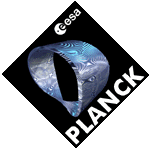|
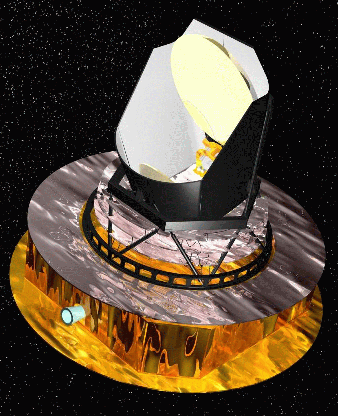 Carefully designed
instruments are required for the accurate measurement of the
CMB. Planck satellite and its instruments have strict
specifications. For example, its receivers are of latest and
finest technology yet. First of all, the satellite must be able
to scan the whole sky -the goal is to achieve 90 percent
coverage. Second, the pointing accuracy of the satellite must
be excellent so that the tiny CMB anisotropies can be measured.
Third, all instruments must produce negligible interference
with the operation of the satellite. Carefully designed
instruments are required for the accurate measurement of the
CMB. Planck satellite and its instruments have strict
specifications. For example, its receivers are of latest and
finest technology yet. First of all, the satellite must be able
to scan the whole sky -the goal is to achieve 90 percent
coverage. Second, the pointing accuracy of the satellite must
be excellent so that the tiny CMB anisotropies can be measured.
Third, all instruments must produce negligible interference
with the operation of the satellite.
Planck satellite operates between frequencies 30
and 857 GHz. The frequency range should be as wide as possible
so that the foreground noise can be efficiently eliminated.
This means that the receivers must be based on two different
techniques. At lower frequencies they are "normal" radio
receivers and at higher frequencies, bolometers. Bearing in
mind the minute nature of the CMB temperature anisotropies, the
instruments should be as sensitive as possible. Planck will be
enormously more sensitive than COBE, and at least ten times
more sensitive than WMAP.
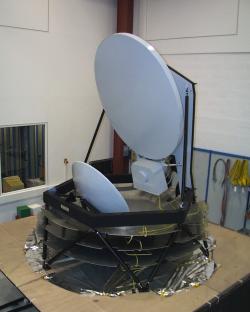 The main reflector mirror
of the Planck satellite is 1.5 metres in diameter and the
sub-reflector is about 0.8 metres in diameter. The design is a
so called off-axis tilted Gregorian system. A shield surrounds
the telescope and focal plane instruments. Its purpose is to
reduce the contamination level of straylight and help keep the
instruments cool. Straylight is caused by the Sun and the
planets, and also by the satellite itself. The main reflector mirror
of the Planck satellite is 1.5 metres in diameter and the
sub-reflector is about 0.8 metres in diameter. The design is a
so called off-axis tilted Gregorian system. A shield surrounds
the telescope and focal plane instruments. Its purpose is to
reduce the contamination level of straylight and help keep the
instruments cool. Straylight is caused by the Sun and the
planets, and also by the satellite itself.
Receivers
LFI and
HFI
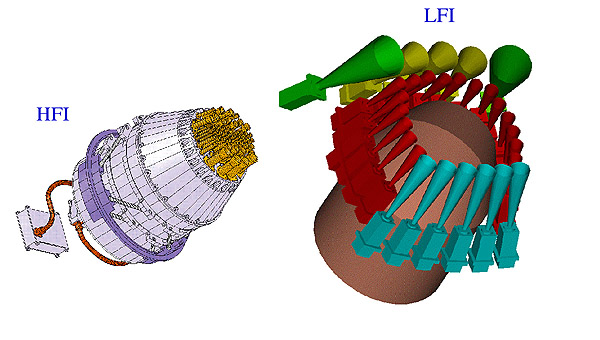 The Low Frequency
Instrument (LFI) operates on frequencies 30, 44 and 70 GHz.
There are several individual receivers at each frequency (4, 6,
and 12, respectively). The High Frequency Instrument (HFI)
operates at frequencies 100, 143, 217, 353, 545, and 857 GHz.
The number of receivers at each frequency is 4, 12, 12, 6, 6
and 6, respectively. The HFI instrument will be installed
inside the LFI instrument. The Low Frequency
Instrument (LFI) operates on frequencies 30, 44 and 70 GHz.
There are several individual receivers at each frequency (4, 6,
and 12, respectively). The High Frequency Instrument (HFI)
operates at frequencies 100, 143, 217, 353, 545, and 857 GHz.
The number of receivers at each frequency is 4, 12, 12, 6, 6
and 6, respectively. The HFI instrument will be installed
inside the LFI instrument.
The twelve 70
GHz receivers are being developed and built in Finland (in
cooperation between Millilab, Ylinen Electronics Co., and
Metsähovi). They use Monolithic Microwave Integrated Circuits
(MMIC) and are about a size of a matchbox! The CMB radiation
must be amplified by a factor of one million as the differences
in the temperature structure are so very small. Because the CMB
is very cold (3 Kelvins or -270 degrees Celsius), the receivers
must be also cooled, otherwise the required sensitivity will
not be reached.
Orbit
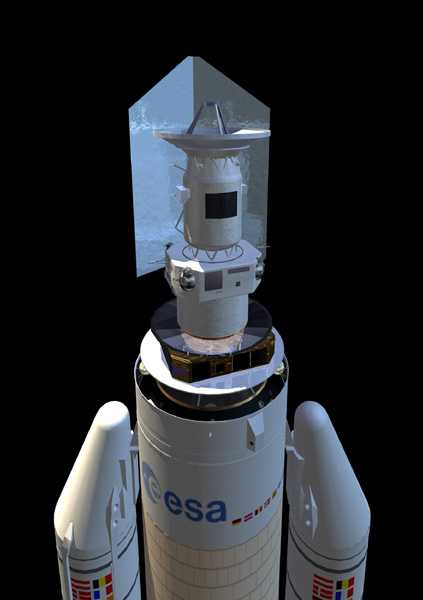 The Planck satellite will be launched on Ariane 5
launch vehicle together with the Herschel satellite. The
baseline orbit chosen for Planck is an elliptical orbit around
the L2 Lagrangian point of the Earth-Sun system. This point is
at a distance of about 1.5 million kilometres from Earth, away
from the direction of the Sun. At this location it is possible
to point the satellite towards the empty space and away from
most sources of interference. Thus the amount of straylight
will be minimal, and the thermal environment stable. The Planck satellite will be launched on Ariane 5
launch vehicle together with the Herschel satellite. The
baseline orbit chosen for Planck is an elliptical orbit around
the L2 Lagrangian point of the Earth-Sun system. This point is
at a distance of about 1.5 million kilometres from Earth, away
from the direction of the Sun. At this location it is possible
to point the satellite towards the empty space and away from
most sources of interference. Thus the amount of straylight
will be minimal, and the thermal environment stable.
 The
telescope is at an angle of 70 degrees to the body of the
satellite. As the satellite spins around, the telescope scans a
narrow slice of the sky. Every day the attitude of the
satellite changes a little, and in about six months the sky has
been covered once. This full-sky measurement is then repeated
to improve sensitivity. The whole mission is predicted to last,
from the launch to the repeated measurement of the last slice
of the sky, about 15 months. The launch is currently scheduled
for 2008. The
telescope is at an angle of 70 degrees to the body of the
satellite. As the satellite spins around, the telescope scans a
narrow slice of the sky. Every day the attitude of the
satellite changes a little, and in about six months the sky has
been covered once. This full-sky measurement is then repeated
to improve sensitivity. The whole mission is predicted to last,
from the launch to the repeated measurement of the last slice
of the sky, about 15 months. The launch is currently scheduled
for 2008.
|
